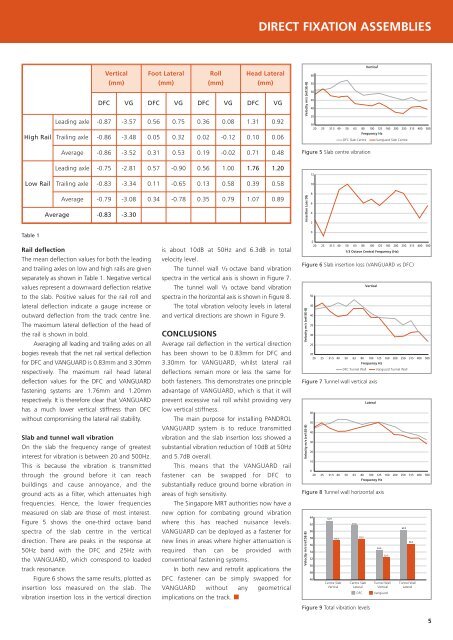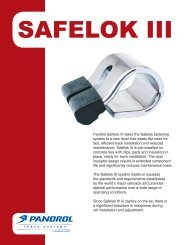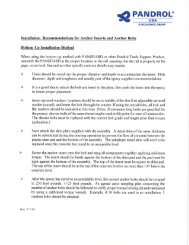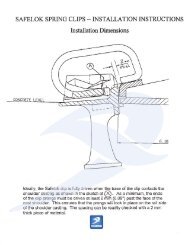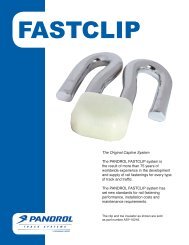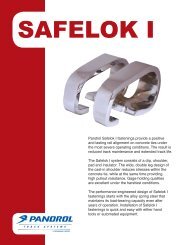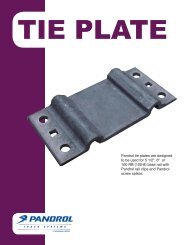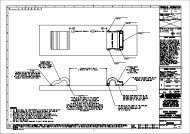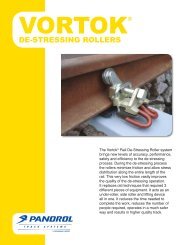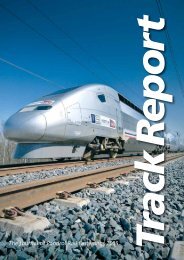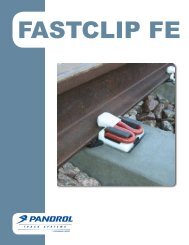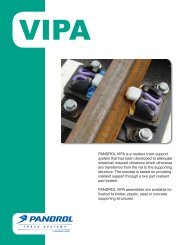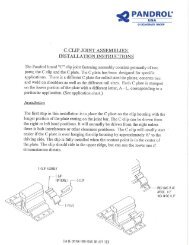The Journal of Pandrol Rail Fastenings 2011 - Pandrol USA
The Journal of Pandrol Rail Fastenings 2011 - Pandrol USA
The Journal of Pandrol Rail Fastenings 2011 - Pandrol USA
You also want an ePaper? Increase the reach of your titles
YUMPU automatically turns print PDFs into web optimized ePapers that Google loves.
DIRECT FIXATION ASSEMBLIES<br />
Vertical<br />
(mm)<br />
Foot Lateral<br />
(mm)<br />
Roll<br />
(mm)<br />
Head Lateral<br />
(mm)<br />
DFC VG DFC VG DFC VG DFC VG<br />
Leading axle -0.87 -3.57 0.56 0.75 0.36 0.08 1.31 0.92<br />
High <strong>Rail</strong><br />
Trailing axle -0.86 -3.48 0.05 0.32 0.02 -0.12 0.10 0.06<br />
Average -0.86 -3.52 0.31 0.53 0.19 -0.02 0.71 0.48<br />
Figure 5 Slab centre vibration<br />
Leading axle -0.75 -2.81 0.57 -0.90 0.56 1.00 1.76 1.20<br />
Low <strong>Rail</strong><br />
Trailing axle -0.83 -3.34 0.11 -0.65 0.13 0.58 0.39 0.58<br />
Average -0.79 -3.08 0.34 -0.78 0.35 0.79 1.07 0.89<br />
Average -0.83 -3.30<br />
Table 1<br />
<strong>Rail</strong> deflection<br />
<strong>The</strong> mean deflection values for both the leading<br />
and trailing axles on low and high rails are given<br />
separately as shown in Table 1. Negative vertical<br />
values represent a downward deflection relative<br />
to the slab. Positive values for the rail roll and<br />
lateral deflection indicate a gauge increase or<br />
outward deflection from the track centre line.<br />
<strong>The</strong> maximum lateral deflection <strong>of</strong> the head <strong>of</strong><br />
the rail is shown in bold.<br />
Averaging all leading and trailing axles on all<br />
bogies reveals that the net rail vertical deflection<br />
for DFC and VANGUARD is 0.83mm and 3.30mm<br />
respectively. <strong>The</strong> maximum rail head lateral<br />
deflection values for the DFC and VANGUARD<br />
fastening systems are 1.76mm and 1.20mm<br />
respectively. It is therefore clear that VANGUARD<br />
has a much lower vertical stiffness than DFC<br />
without compromising the lateral rail stability.<br />
Slab and tunnel wall vibration<br />
On the slab the frequency range <strong>of</strong> greatest<br />
interest for vibration is between 20 and 500Hz.<br />
This is because the vibration is transmitted<br />
through the ground before it can reach<br />
buildings and cause annoyance, and the<br />
ground acts as a filter, which attenuates high<br />
frequencies. Hence, the lower frequencies<br />
measured on slab are those <strong>of</strong> most interest.<br />
Figure 5 shows the one-third octave band<br />
spectra <strong>of</strong> the slab centre in the vertical<br />
direction. <strong>The</strong>re are peaks in the response at<br />
50Hz band with the DFC and 25Hz with<br />
the VANGUARD, which correspond to loaded<br />
track resonance.<br />
Figure 6 shows the same results, plotted as<br />
insertion loss measured on the slab. <strong>The</strong><br />
vibration insertion loss in the vertical direction<br />
is about 10dB at 50Hz and 6.3dB in total<br />
velocity level.<br />
<strong>The</strong> tunnel wall 1 /3 octave band vibration<br />
spectra in the vertical axis is shown in Figure 7.<br />
<strong>The</strong> tunnel wall 1 /3 octave band vibration<br />
spectra in the horizontal axis is shown in Figure 8.<br />
<strong>The</strong> total vibration velocity levels in lateral<br />
and vertical directions are shown in Figure 9.<br />
CONCLUSIONS<br />
Average rail deflection in the vertical direction<br />
has been shown to be 0.83mm for DFC and<br />
3.30mm for VANGUARD, whilst lateral rail<br />
deflections remain more or less the same for<br />
both fasteners. This demonstrates one principle<br />
advantage <strong>of</strong> VANGUARD, which is that it will<br />
prevent excessive rail roll whilst providing very<br />
low vertical stiffness.<br />
<strong>The</strong> main purpose for installing PANDROL<br />
VANGUARD system is to reduce transmitted<br />
vibration and the slab insertion loss showed a<br />
substantial vibration reduction <strong>of</strong> 10dB at 50Hz<br />
and 5.7dB overall.<br />
This means that the VANGUARD rail<br />
fastener can be swapped for DFC to<br />
substantially reduce ground borne vibration in<br />
areas <strong>of</strong> high sensitivity.<br />
<strong>The</strong> Singapore MRT authorities now have a<br />
new option for combating ground vibration<br />
where this has reached nuisance levels.<br />
VANGUARD can be deployed as a fastener for<br />
new lines in areas where higher attenuation is<br />
required than can be provided with<br />
conventional fastening systems.<br />
In both new and retr<strong>of</strong>it applications the<br />
DFC fastener can be simply swapped for<br />
VANGUARD without any geometrical<br />
implications on the track. n<br />
Figure 6 Slab insertion loss (VANGUARD vs DFC)<br />
Figure 7 Tunnel wall vertical axis<br />
Figure 8 Tunnel wall horizontal axis<br />
Figure 9 Total vibration levels<br />
5


